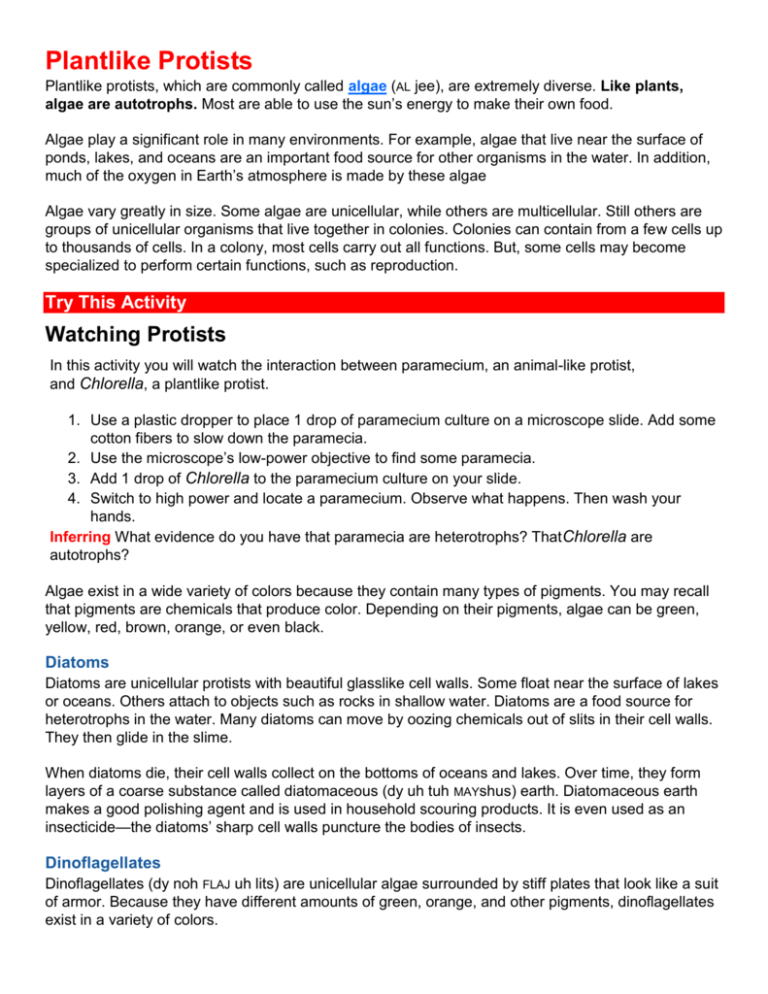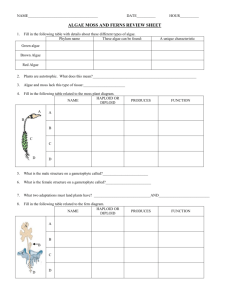Plantlike Protists Plantlike protists, which are commonly called algae
advertisement

Plantlike Protists Plantlike protists, which are commonly called algae (AL jee), are extremely diverse. Like plants, algae are autotrophs. Most are able to use the sun’s energy to make their own food. Algae play a significant role in many environments. For example, algae that live near the surface of ponds, lakes, and oceans are an important food source for other organisms in the water. In addition, much of the oxygen in Earth’s atmosphere is made by these algae Algae vary greatly in size. Some algae are unicellular, while others are multicellular. Still others are groups of unicellular organisms that live together in colonies. Colonies can contain from a few cells up to thousands of cells. In a colony, most cells carry out all functions. But, some cells may become specialized to perform certain functions, such as reproduction. Try This Activity Watching Protists In this activity you will watch the interaction between paramecium, an animal-like protist, and Chlorella, a plantlike protist. 1. Use a plastic dropper to place 1 drop of paramecium culture on a microscope slide. Add some cotton fibers to slow down the paramecia. 2. Use the microscope’s low-power objective to find some paramecia. 3. Add 1 drop of Chlorella to the paramecium culture on your slide. 4. Switch to high power and locate a paramecium. Observe what happens. Then wash your hands. Inferring What evidence do you have that paramecia are heterotrophs? That Chlorella are autotrophs? Algae exist in a wide variety of colors because they contain many types of pigments. You may recall that pigments are chemicals that produce color. Depending on their pigments, algae can be green, yellow, red, brown, orange, or even black. Diatoms Diatoms are unicellular protists with beautiful glasslike cell walls. Some float near the surface of lakes or oceans. Others attach to objects such as rocks in shallow water. Diatoms are a food source for heterotrophs in the water. Many diatoms can move by oozing chemicals out of slits in their cell walls. They then glide in the slime. When diatoms die, their cell walls collect on the bottoms of oceans and lakes. Over time, they form layers of a coarse substance called diatomaceous (dy uh tuh MAYshus) earth. Diatomaceous earth makes a good polishing agent and is used in household scouring products. It is even used as an insecticide—the diatoms’ sharp cell walls puncture the bodies of insects. Dinoflagellates Dinoflagellates (dy noh FLAJ uh lits) are unicellular algae surrounded by stiff plates that look like a suit of armor. Because they have different amounts of green, orange, and other pigments, dinoflagellates exist in a variety of colors. FIGURE 19Dinoflagellates Dinoflagellates whirl through the water with their flagella. All dinoflagellates have two flagella held in grooves between their plates. When the flagella beat, the dinoflagellates twirl like toy tops as they move through the water. Many glow in the dark. They light up the ocean’s surface when disturbed by a passing boat or swimmer. Euglenoids Euglenoids (yoo GLEE noydz) are green, unicellular algae that are found mostly in fresh water. Unlike other algae, euglenoids have one animal-like characteristic—they can be heterotrophs under certain conditions. When sunlight is available, most euglenoids are autotrophs that produce their own food. However, when sunlight is not available, euglenoids will act like heterotrophs by obtaining food from their environment. Some euglenoids live entirely as heterotrophs. FIGURE 20Euglena The euglena is a common euglenoid that lives in fresh water. In sunlight, many euglenas can make their own food. Without sunlight, they obtain food from their environment. Interpreting Diagrams What structures help a euglena find and move toward light? In Figure 20, you see a euglena, which is a common euglenoid. Notice the long, whiplike flagellum that helps the organism move. Locate the eyespot near the flagellum. Although the eyespot is not really an eye, it contains pigments. These pigments are sensitive to light and help the euglena recognize the direction of a light source. You can imagine how important this response is to an organism that needs light to make food. Skills Activity Predicting Predict what will happen when you pour a culture of euglena into a petri dish, and then cover half the dish with aluminum foil. Give a reason for your prediction. Then carry out the experiment with a culture of euglena in a plastic petri dish. Cover half the dish with aluminum foil. After 10 minutes, uncover the dish. What do you observe? Was your prediction correct? Explain why euglena behave this way. Red Algae Almost all red algae are multicellular seaweeds. Divers have found red algae growing more than 260 meters below the ocean’s surface. Their red pigments are especially good at absorbing the small amount of light that is able to reach deep ocean waters. People use red algae in a variety of ways. Carrageenan (ka ruh JEE nun) and agar, substances extracted from red algae, are used in products such as ice cream and hair conditioner. For people in many Asian cultures, red algae is a nutrient-rich food that is eaten fresh, dried, or toasted. Green Algae Green algae, which contain green pigments, are quite diverse. Most green algae are unicellular. Some, however, form colonies, and a few are multicellular. Most green algae live in either fresh water or salt water. The few that live on land are found on rocks, in the crevices of tree bark, or in moist soils. FIGURE 21Green Algae Green algae range in size from unicellular organisms to multicellular seaweeds. This multicellular sea lettuce, Ulva, lives in oceans. Green algae are actually very closely related to plants that live on land. Green algae and plants contain the same type of chlorophyll and share other important similarities. In fact, some scientists think that green algae belong in the plant kingdom. FIGURE 22Brown Algae Giant kelps are brown algae that have many plantlike structures.Interpreting Diagrams What plant structures do the kelp’s holdfasts and blades resemble? Brown Algae Many of the organisms that are commonly called seaweeds are brown algae. In addition to their brown pigment, brown algae also contain green, yellow, and orange pigments. As you can see in Figure 22, a typical brown alga has many plantlike structures. Holdfasts anchor the alga to rocks. Stalks support the blades, which are the leaflike structures of the alga. Many brown algae also have gas-filled sacs called bladders that allow the algae to float upright in the water. Brown algae flourish in cool, rocky waters. Brown algae called rockweed live along the Atlantic coast of North America. Giant kelps, which can grow as long as 100 meters, live in some Pacific coastal waters. The giant kelps form large underwater “forests” where many organisms, including sea otters and abalone, live. Some people eat brown algae. In addition, substances called algins are extracted from brown algae and used as thickeners in puddings and other foods.








